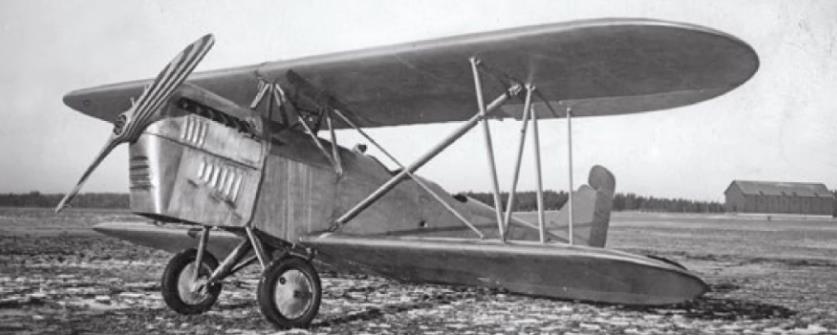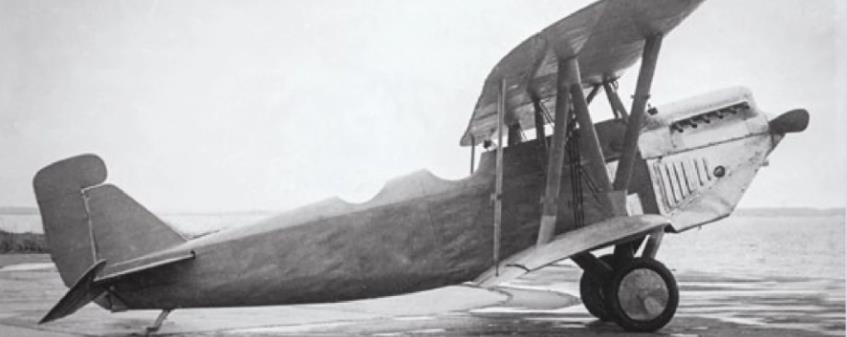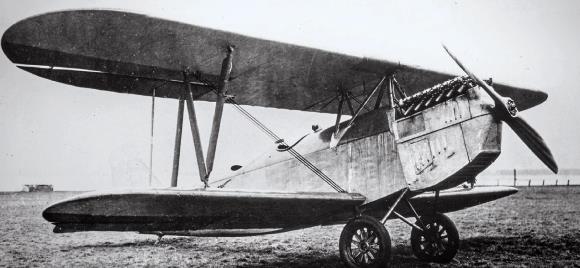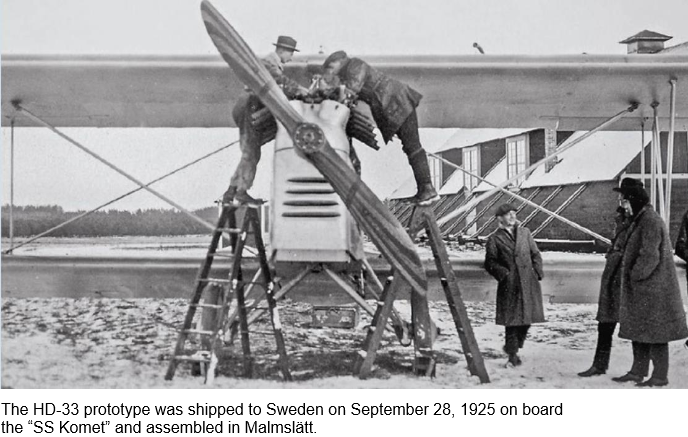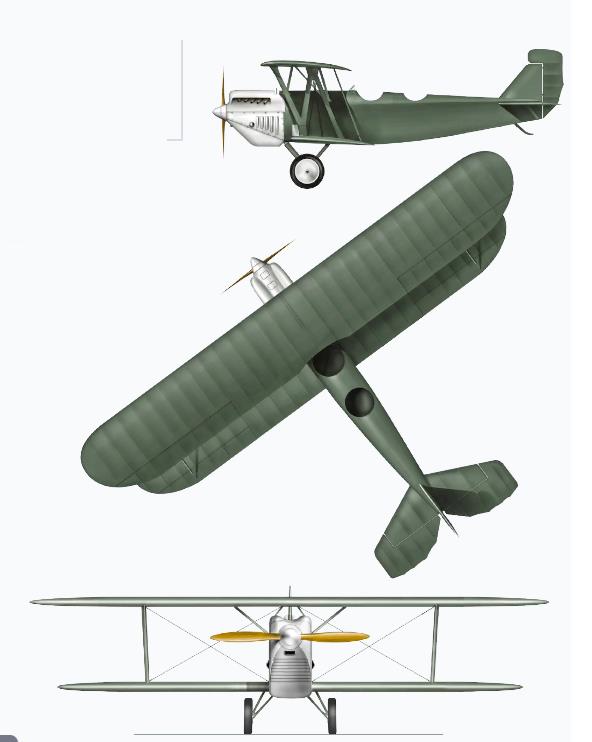| Type |
Two seat reconnaissance and light bomber |
| Engine |
BMW VI with a 2-bladed propeller |
| Dimensions |
Length 9,4 m , height 4,00 m , span upper 12,8 m, lower 11,4 m15,0 m , wing area 43,3 m2 , |
| Weights |
Empty 1600 kg, loaded 2730 kg, max. take off weight fuel 900 l |
| Performance |
Max.. speed 246 km/h , landing speed 90 km/h, cruising speed 195 km/h, range 200 ? km , endurance 6,0 h , service ceiling 6200 m , climb to 1000 m 3,1 min., to 3000 m 11,4 min. |
| Armament |
|
| Type |
Werk.Nr |
Registration |
History |
|
237 |
S-21, D-1205 |
Tested in Sweden 1925/1926. Back to Heinkel , minor modifications. To DVL later to Albatros GmbH. Stricken from register February 1932 |
The HD 33 was a two-seat biplane powered by an Armstrong Siddeley Puma inline engine. It first flew in 1928 but initial flight tests showed disappointing aircraft, so the plane was returned to its manufacturer and fitted with a BMW VI engine as well as a new radiator, thus being redesignated HD 33a. After flight tests in this new configuration, the aircraft was to be transferred to the flight test center in Lipitsk, but the German military abandoned the idea and the HD.33 remained a prototype only. Plans for a civilian version never materialized.
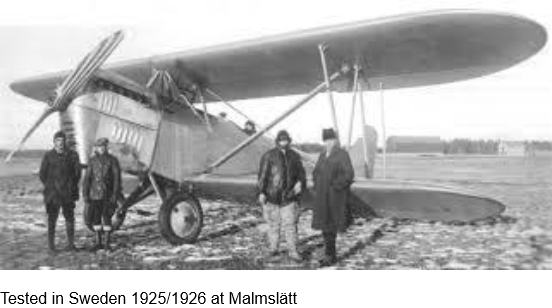
As early as the early 1920s, Ernst Heinkel had good contacts with the military, both with the airborne units of the Hecies and with the naval aviation. Even though the first company headquarters in Warnemünde was still small, in 1923 Ernst Heinkel received the first, still secret, order from the naval aviation. Ten Heinkel HF 1s were to be built. The transactions that led to the first order from the army were shrouded in secrecy, and today only a few details are known. On December 1922, the Dinos automobile factory signed. the Lemkel branch in Warnemünde and Sablatnig Flugzeugbau reached an agreement whereby Dinos would supply two military aircraft to the Soviet trade delegation in Berlin and have them built by Ileinkei. The requirement was for a two-seat reconnaissance aircraft with a top speed of at least 220 km/h and a service height of between 1,000 and 6,000 meters. If this agreement was not implemented, the two Heinkel HD 17s, which were probably built outside of the Soviet order, would instead be shipped to the ISA and tested by the LS Army. One of them had previously been tested in August 1924 by WaPrw 6F (Testing Department), the Reich Ministry of Aviation (RWM) responsible for development and testing, and had been judged to be a suitable candidate for meeting the requirements set by the Air Defense Department. I A(L). An aircraft was to be found that would be suitable for observer training in the Russian U-pe/L, the secret air force training center.Ori. was needed. The order was placed on 14 January 1926.
In March 1921 a photo of an HD 17 appeared in the British aviation journal "The Aeroplatte". Heinkel was immediately instructed by the RWM to carry coffins for it, "leave nothing to be desired about the secret production and to keep the public secret." He was to explain that the machines present came from the Swedish Navy and had been built by Svensk Aeronautical Institute.
From then on, this worked so well that in the 1927 Pocket Book of Air Fleets the HD 17 was listed as a Svensk Aeronautical Institute product. Two years earlier, the HD 17 was already equipped with a more powerful öOÜ-PS-BMW'-VI engine from designed: Thus the HD 33 was born and was included in the lists and the development plan (technical work plan) of the following years. It was called "long-range reconnaissance and day bombing". At the end of 1925 the HD 33 was also included in the "Cosmetic Program B" for emergencies. In case of emergency, 373 units were to be ordered. Actually, for an army of 15 divisions, 1,000 units would have been enough for the flying units. Compared to the HD 17, the HD 33 had a slightly larger wing and was 21.5 kilograms heavier. The other dimensions were the same as those of the HD 17. A prototype type (model number 2.37 with BMW-VI engine) was ordered by the WaPrw hF mxl of the DVL (German Research Institute for Aviation). Department M and completed in the autumn of 1925. Heinkel tried to persuade the Inter-Allied Aviation Committee to approve the HF 33 as a "mail plane" with a 240 hp Armstrong-Siddley Puma engine and, to his surprise, he actually succeeded. A further attempt to approve the HD 33a with the 300 hp BMW-IV engine was rejected on February 19, 1926. It was clear that the 11L> 33 could not be flown officially and legally in Warnemünde with the planned more powerful 600 hp engine, and Heinkel asked Carl Clemens Rücker, the company founder and operations manager of Svenska Acro, to make arrangements for the first test flights in Sweden. Accordingly, Svendta Aero applied for Swedish permission to test a new model "for America" at Malmö's Ikebukuro, the Swedish Air Force's airfield. This was granted, and in October company pilot Gustav Basser, who was later replaced by Eberhard Mohnke, director Friedrich Kasingr, engineer Rtidoll Schweigen, were commissioned. Mechanic Fritz (Haussen) and the engine assemblers Adolf Levendecker and Hermann Schneider were sent to Sweden. Ernst Blume, engine assembler Fritz (Schnmüller) and Einst Heinkel himself later came to Sweden. The HD 33 was shipped to Stockholm on 28 September 1923 on board the SS Komet and taken by train to Mulmslutt. After assembly, it was test flown between October 1425 and February 1926 and then returned to Warnemünde. The tests were postponed due to bad weather and a landing accident. Repairs and the replacement of the beeper were necessary. A nice, parked undercarriage was fitted and metal panels were added to the suit wires between the fuselage and the fuselage. and immobilized surfaces. It was planned to prepare the HD 33 for shipment to the German test center
in Lipetsk by June 1926. The decomposition tests carried out by the DVL in April and May
However, the tests were not satisfactory. Despite modifications that included a new engine storage facility, a new engine with higher compression, a propeller shaft and changes to the cooling system, the problems could not be resolved. Further secret test flights were carried out early in the morning and late in the evening. Kurt Student, head of the WaPrw 6F, was sometimes accompanied by Helmuth Wilberg and often by Hans Jeschonneck - both officers in the Secret Military Aviation Office of the Reichswehr. ministeriums visited Warnemünde
and Heinkel wrote in his autobiography
“Stormy Life”: “Student could never be secret enough. So he made his own inspection visits. There was a huge stir once when he managed to climb over the airfield fence unnoticed before dawn and get right up to my ‘delicate’ hall. On the other hand, Student and his people were so obsessed with flying that they wanted to fly my designs themselves if possible. (...) They appeared then in the middle of the night, preferably before 3 a.m., and flew in. At 5 or 6 a.m. it was over again, at a time when people in Warnemünde were generally still lounging in their beds. Nevertheless, the engines made so much noise that real secrecy could only be discussed with great gusto." In January 1927 it was clear that the HD 33 left much to be desired and although the technical tests were completed, it could not be sent to Lipetsk. New safety and speed measuring devices were tested in March 1927 by Heinkel's chief pilot Stephan von Prondzynski and Eberhardt Mohnike, and the HD 3 remained as a test aircraft under the name of the WaPrw 6F. At the DVL (later Albatros!) in Adelshol it was registered as the D 1205 and remained in the inventory until it was deleted in February 1932. After the flop with the HD 33 Ernst Heinkel tried a new approach. To improve performance, a second engine was added. The new type was listed in the development plans as an alternative reconnaissance aircraft, as a high-altitude turboprop aircraft and as a reconnaissance aircraft for medium distances at high altitudes, short-haul. A prototype, the HD 34, was commissioned in August 1927 by Student/WaPrw 6F. This flew in the summer of 1928, but was destroyed in an emergency landing on June 23rd. The military eventually gave up the twin-engine route. The next prototype was the HD 41, which was eventually developed into the more successful He 45.
